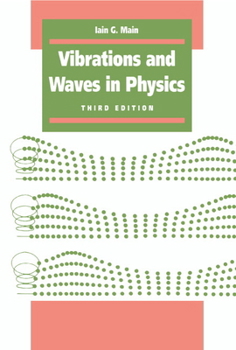Vibrations and Waves in Physics
Select Format
Select Condition 
Book Overview
For the third edition of this successful undergraduate text, the author has made a number of changes to improve the presentation and clarify some of the arguments, and has also brought several of the applications up to date. The new material includes an elementary, descriptive introduction to the ideas behind the new science of chaos. The overall objectives of the book are unchanged: to lead the student to a thorough understanding of the basic concepts of vibrations and waves, to show how these concepts unify a wide variety of familiar physics, and to open doors to advanced topics which they illuminate. Each section of the book contains a brief summary of its salient contents. There are approximately 180 problems to which all numerical answers are provided, together with hints for their solution. This book is designed both for use as a text for an initial undergraduate course on vibrations and waves, and for a reference at later stages when more advanced topics or applications are met.
Format:Paperback
Language:English
ISBN:0521447011
ISBN13:9780521447010
Release Date:August 1989
Publisher:Cambridge University Press
Length:380 Pages
Weight:1.35 lbs.
Dimensions:0.9" x 6.0" x 9.0"
Customer Reviews
1 rating
Great advanced introduction
Published by Thriftbooks.com User , 18 years ago
Based on the small number of reviews here, this work appears to be relatively unknown and unsung here. Allow me to contribute a hearty "thumbs up" here because I feel it is a great packaging of well-selected basics and intuition. If you are a student advancing in physics and dynamics, I hope it at least gets on your list of things to check out. I personally love this book! However, I am long beyond (in time, if not in learning) introductory physics; so let me try to make an informed recommendation. I think this should be your SECOND waves book. I can see how readers using it for a first exposure to waves or partial differential equations can feel challenged, as it is concise and often leaves you alone. And in return for its conciseness it treats a wider and more advanced set of topics than I remember in my "first" introduction books: Eg, nice first tastes of nonlinearity, solitons, water waves. But at this slightly advanced level of this book, it has a lot to offer, and I find it unique: - The topic selection is terrific! Just to give you an example: It provides an introductory treatment of the Klein-Gordon equation (and I don't know why other basic books don't), nicely illustrated in the book as a system involving something like a set of mattress box springs. If you happen to go on to more advanced work, eg quantum physics and the origin of mass, you might think back to this "mattress" picture and have some extra basic intuition about it. This is just one example of how I find that the topics selected by this book "fall into place" elsewhere in my travels. - The book sticks to an introductory level on the wide variety of topics and uses the short space to convey fundamental intuition. It is certainly not a thorough / detailed / last word treatment on any of the topics-- but I would not want to bore myself reading such technical detail cover to cover. Instead, I can almost imagine an author that very much sees the big picture-- bigger than can fit into many books--, carefully chose the most important aspects and intuitions to convey, and then enthusiastically, perhaps impatiently, tried to compress and convey it as fast as possible. Lastly, as a "later" book you study on the subject, its conciseness and speed might be just right-- eg, good for a fast track conceptual review without fluff. What was my "first" book on this subject? I don't even remember now. But this book is still on my shelf, on my mind, and I'm thankful enough to write a review!





